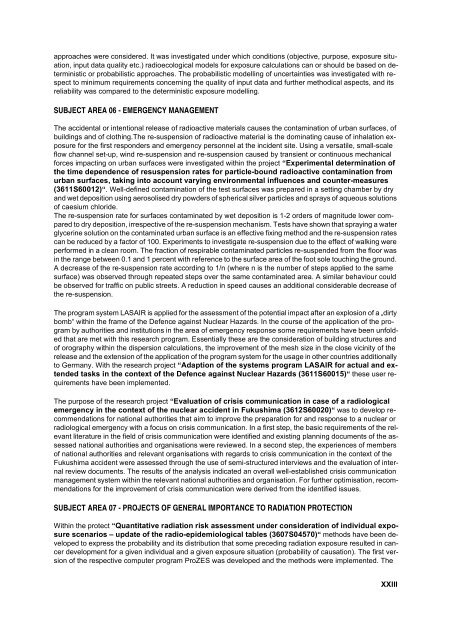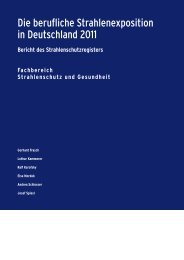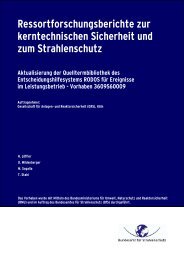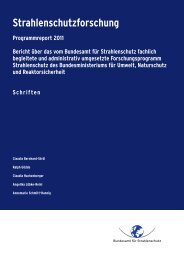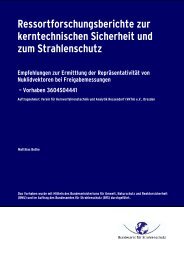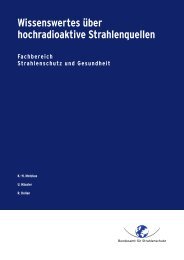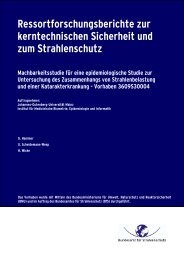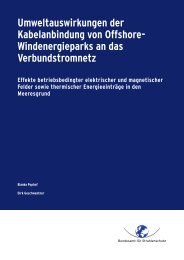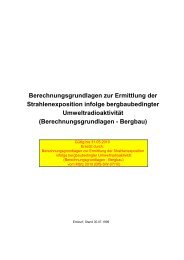Programmreport 2012 - DORIS - Bundesamt für Strahlenschutz
Programmreport 2012 - DORIS - Bundesamt für Strahlenschutz
Programmreport 2012 - DORIS - Bundesamt für Strahlenschutz
Sie wollen auch ein ePaper? Erhöhen Sie die Reichweite Ihrer Titel.
YUMPU macht aus Druck-PDFs automatisch weboptimierte ePaper, die Google liebt.
approaches were considered. It was investigated under which conditions (objective, purpose, exposure situation,<br />
input data quality etc.) radioecological models for exposure calculations can or should be based on deterministic<br />
or probabilistic approaches. The probabilistic modelling of uncertainties was investigated with respect<br />
to minimum requirements concerning the quality of input data and further methodical aspects, and its<br />
reliability was compared to the deterministic exposure modelling.<br />
SUBJECT AREA 06 - EMERGENCY MANAGEMENT<br />
The accidental or intentional release of radioactive materials causes the contamination of urban surfaces, of<br />
buildings and of clothing.The re-suspension of radioactive material is the dominating cause of inhalation exposure<br />
for the first responders and emergency personnel at the incident site. Using a versatile, small-scale<br />
flow channel set-up, wind re-suspension and re-suspension caused by transient or continuous mechanical<br />
forces impacting on urban surfaces were investigated within the project “Experimental determination of<br />
the time dependence of resuspension rates for particle-bound radioactive contamination from<br />
urban surfaces, taking into account varying environmental influences and counter-measures<br />
(3611S60012)“. Well-defined contamination of the test surfaces was prepared in a setting chamber by dry<br />
and wet deposition using aerosolised dry powders of spherical silver particles and sprays of aqueous solutions<br />
of caesium chloride. <br />
The re-suspension rate for surfaces contaminated by wet deposition is 1-2 orders of magnitude lower compared<br />
to dry deposition, irrespective of the re-suspension mechanism. Tests have shown that spraying a water<br />
glycerine solution on the contaminated urban surface is an effective fixing method and the re-suspension rates<br />
can be reduced by a factor of 100. Experiments to investigate re-suspension due to the effect of walking were<br />
performed in a clean room. The fraction of respirable contaminated particles re-suspended from the floor was<br />
in the range between 0.1 and 1 percent with reference to the surface area of the foot sole touching the ground.<br />
A decrease of the re-suspension rate according to 1/n (where n is the number of steps applied to the same<br />
surface) was observed through repeated steps over the same contaminated area. A similar behaviour could<br />
be observed for traffic on public streets. A reduction in speed causes an additional considerable decrease of<br />
the re-suspension.<br />
The program system LASAIR is applied for the assessment of the potential impact after an explosion of a „dirty<br />
bomb“ within the frame of the Defence against Nuclear Hazards. In the course of the application of the program<br />
by authorities and institutions in the area of emergency response some requirements have been unfolded<br />
that are met with this research program. Essentially these are the consideration of building structures and<br />
of orography within the dispersion calculations, the improvement of the mesh size in the close vicinity of the<br />
release and the extension of the application of the program system for the usage in other countries additionally<br />
to Germany. With the research project “Adaption of the systems program LASAIR for actual and extended<br />
tasks in the context of the Defence against Nuclear Hazards (3611S60015)“ these user requirements<br />
have been implemented.<br />
The purpose of the research project “Evaluation of crisis communication in case of a radiological<br />
emergency in the context of the nuclear accident in Fukushima (3612S60020)“ was to develop recommendations<br />
for national authorities that aim to improve the preparation for and response to a nuclear or<br />
radiological emergency with a focus on crisis communication. In a first step, the basic requirements of the relevant<br />
literature in the field of crisis communication were identified and existing planning documents of the assessed<br />
national authorities and organisations were reviewed. In a second step, the experiences of members<br />
of national authorities and relevant organisations with regards to crisis communication in the context of the<br />
Fukushima accident were assessed through the use of semi-structured interviews and the evaluation of internal<br />
review documents. The results of the analysis indicated an overall well-established crisis communication<br />
management system within the relevant national authorities and organisation. For further optimisation, recommendations<br />
for the improvement of crisis communication were derived from the identified issues.<br />
SUBJECT AREA 07 - PROJECTS OF GENERAL IMPORTANCE TO RADIATION PROTECTION<br />
Within the protect “Quantitative radiation risk assessment under consideration of individual exposure<br />
scenarios – update of the radio-epidemiological tables (3607S04570)“ methods have been developed<br />
to express the probability and its distribution that some preceding radiation exposure resulted in cancer<br />
development for a given individual and a given exposure situation (probability of causation). The first version<br />
of the respective computer program ProZES was developed and the methods were implemented. The<br />
XXIII


